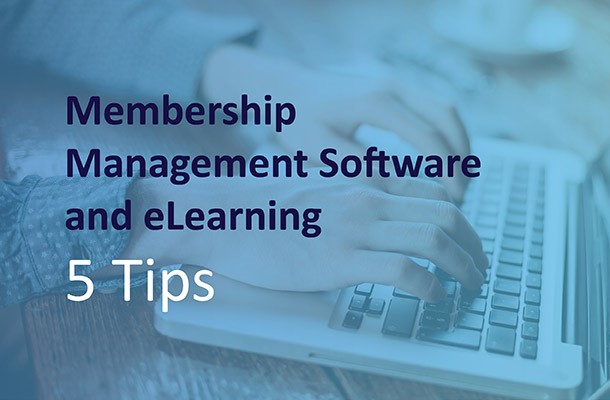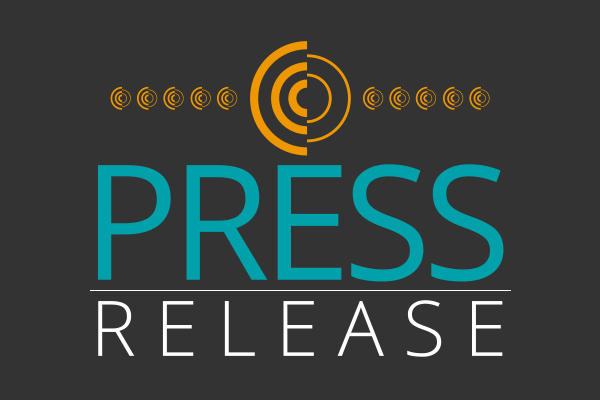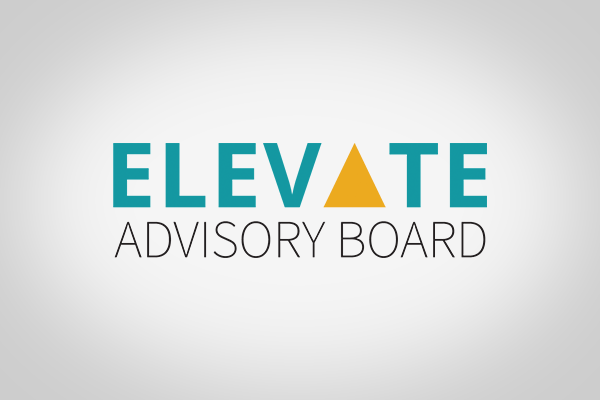
by Aubrey Mellos | Sep 7, 2018 | Blog
Guest blog by Jake Fabbri, Senior Vice President, Marketing – Fonteva, Inc.
Whether it’s online courses, learning sessions, discussion forums, streaming seminars, or live webinars — when it comes to eLearning and the value it can bring to your organization, the possibilities are endless!
You might already understand the value of eLearning from a marketing or sales perspective, but it can also be a great tool for online users. Offering useful information and training can go a long way to familiarize online users with your space, while also creating a great impression for continued engagement.
If your membership management solution supports eLearning and event planning, both online and in-person, are you making the most of it?
eLearning is a major engagement opportunity for organizations ready to make the most of their tools in smarter ways. We’ve highlighted a few of the most important benefits that effective membership management software can have for your eLearning efforts. Your software should accomplish the following:
- Foster community
- Give members the flexibility they need
- Offer integrated eLearning opportunities
- Encourage networking and extended engagement
- Collect and analyze rich eLearning data
Your eLearning program shouldn’t have to be cobbled together! Any effective software solution should give you the tools you need to plan, organize, and manage your courses and sessions more effectively than ever. Ready to learn how? Let’s dive in.
1. Foster Community
Making the most of your eLearning capabilities starts with building a sense of community. By this we mean a feeling of mutual understanding and belonging, of being drawn together in support of a larger goal.
We also mean literally grouping your members together into online communities!
Of course, the benefits of encouraging the more abstract meaning of community are obvious. Validating your members’ feelings of inclusion and usefulness are essential. The benefits of digitally managing communities for your members can be just as significant. They include:
- Encouraging interaction and engagement, with you and with each other
- Creating custom permissions based on membership levels and communities
- Allowing members to create and manage their own subgroups and committees
- Extending discussions and collaboration between members
- Creating a stronger culture of peer support and interaction
- Boosting interest in your in-person events and sessions
Making it easier to engage with your work is the first step (and often the most effective way) to boost engagement all around. Your management software should actively help you build a more distinct sense of community and shared purpose in your program!
Doing so will lay a strong foundation for the new eLearning programs you develop. Simply providing the tools to strengthen community ties between members can provide a serious boost in interest for your upcoming programming.
2. Give Members the Flexibility They Need
Your membership management software must offer features that are flexible and truly useful. They should definitely be geared to you as an administrator, manager, or executive, but they must also apply to your members!
Member-facing flexibility is crucial for actually engaging users with eLearning programs. Otherwise, they might feel underappreciated, or as if they’re simply being treated as customers rather than full members. Prioritizing UX is certainly a good place to start.
More generally, you should use membership management software that’s already built on a flexible platform like Salesforce, or one that integrates seamlessly with the management tools you already use. Membership tools that work with your underlying management system should include integrated reporting, member profiles, and automation features.
Your members need effective, flexible tools, too! Make sure your management software gives your members the freedom to really have a say in how they engage with your programming. They might want to:
- Create and manage their own subgroups within communities
- Form committees to formally conduct program business
- Allow chapters to fully plan their own online and in-person events
- Foster small- and large-scale collaboration between communities
- Create smarter reports and draw from program data to make decisions
Imagine hosting a major convention for all your chapters. Now imagine if each chapter, committee, group, or community were able to plan their own learning sessions and seminars. They could easily share their updates and insights with the rest of your members, generating big-picture thinking and a stronger sense of community.
Now imagine taking that capability online! Offering that same level of freedom and variety with your eLearning programming leads to richer relationships with (and within) your organization.
Not all membership management software can offer this level of flexibility, though. Be sure to conduct an exhaustive membership software comparison before making any changes.
3. Offer Integrated eLearning Opportunities
Working to integrate your online eLearning experiences with your live programming is a best practice that many associations and organizations overlook. This is often because their management doesn’t offer intuitive planning tools, or it’s because they get trapped in a certain way of thinking. Don’t think of your programming events as separate, disjointed units!
All of your educational programming should work together to enrich your members’ experience and invest in their development. This includes your live, in-person programming like keynote addresses and panels and your live, online events, like live-streamed seminars, lectures, or presentations.
For instance, offering live seminars, live-streamed online versions, and recorded webinar versions for later use is an excellent way to make sure everyone who wants to engage with your eLearning content can.
This connects back to the flexibility we discussed in the previous section. Simply put, integrating your educational programming across outlets and events offers your users more opportunities to get involved. The result is increased engagement all around.
There are a few reasons why this comprehensive planning – connecting your digital, live, and in-person programming – is a best practice. It has major benefits, including:
- Increased opportunities for new or inactive members. Offer more ways to get involved, then connect all of them for maximum effect. Inactive members might just need a new way to engage with your programming.
- Strengthened connections within your network. Integrated community features of your software help everyone get to know each other before the event, then it gives them an easy way to stay in touch afterwards.
- Boosted engagement with gamification and badging features. Tie digital rewards to in-person attendance and vice-versa using your management platform.
For the best results, use a membership management platform that’s built on a larger, comprehensive system. For instance, integrated Salesforce event management features can totally support your eLearning efforts and take them to the next level.
4. Encourage Networking and Extended Engagement
The right membership management software can facilitate interactions between your members like never before. After all, the point of your program or association is to bring like-minded individuals together around a shared interest, cause, or profession.
Your eLearning programming should facilitate increased activity at every level. Members should be able to interact naturally in a variety of ways:
- Engaging directly with your program via online eLearning content
- Attending in-person gatherings and sessions
- Interacting with each other in membership communities
- Collaborating on community, group, or committee projects
- Engaging with each other in learning and discussion sessions
- Networking both online and in-person
Effective membership management tools can offer member-facing networking features that provide a serious boost to your rates of engagement with eLearning programming. For instance, member self service tools, engagement scoring, and chapter or committee microsites make it easier for your members to identify one another and make connections.
Combined with an integrated approach to programming (above in Section 3), these features can contribute to a robust culture of interaction in your community.
Let’s say all your users can freely engage with one another on your eLearning presentation software, posting discussion comments and seeing each other’s interactions during webinars. Extremely productive collaborative relationships emerge when those discussions spill over from the webinar to a newly-formed committee in your management platform!
Start with this rundown of some top membership management tools from Double the Donation to study up on ways to boost engagement and unite all your programming efforts.
5. Collect and Analyze Rich eLearning Data
One last essential benefit that your membership management software should provide in relationship to your eLearning program involves data. Of course, data collection is one of the major benefits of any integrated management or planning system, but this is particularly true of any program that regularly engages its members with online-only content.
There are a few ways that your membership platform can benefit your eLearning programming through smarter data collection and analytics tools, including:
- Self-service data collection. Giving your members the ability to freely update their own information results in more data overall. Engaged and excited members will happily provide you with their professional histories, interests, or additional contact info.
- Awards, credits, and badges. As we’ve touched on in other sections, try offering special achievements then tying them to particular levels of engagement with your eLearning program. This provides an easy way to track and measure those activities.
- Program analytics. A comprehensive but flexible membership management system will offer analytics tools to generate smarter reports on any aspect of your program. These insights will help you track engagement, sign-up, and session attendance metrics.
Access to richer, more comprehensive sources of data like this will directly contribute to your organization’s or association’s ability to make more precise budgets. Plus, adapting to your members’ preferences and interests in real time creates more engaged communities in the long run!
Make sure any membership or eLearning software you use includes intuitive analytics tools and seamless reporting to your CRM or other underlying platform.
Offering your members and the wider community eLearning programming is an excellent way to keep your base of support engaged with your work. More importantly, it represents the value that you place on your members, investing in their professional and personal development.
If your membership software isn’t actively contributing to your eLearning planning, strategy, and management, you’re missing out. Get all your tools in sync for the best results! If you’re looking for new or updated management tools, be sure to review some of the most essential features to look for with Fonteva’s comprehensive membership software guide.

by Aubrey Mellos | Jul 9, 2018 | News
Department of Commerce Certification Highlights CommPartners’ Commitment to Privacy
Columbia, MD – July 10, 2018. CommPartners, provider of Elevate Learning Management System, webinar, webcast, and livestream solutions has been certified by the U.S. Department of Commerce and the European Commission under the EU-U.S. Privacy Shield Framework.
The EU-U.S. Privacy Shield Framework provides companies on both sides of the Atlantic with a mechanism to comply with data protection requirements when transferring personal data from the European Union and Switzerland to the United States in support of transatlantic commerce.
“CommPartners is committed to protecting the privacy of our customers and their users. Our customers are very important to us and we want to ensure that their personal information is always safeguarded. We voluntarily self-certified with the EU-U.S. Privacy Shield Framework to ensure our customers have the most up-to-date and appropriate protection,” said Richard Finstein, CEO, CommPartners.
Client data and proprietary information is used by CommPartners for the sole purpose of creating more relevant learning experiences for users of Elevate Learning Management System. CommPartners will only partner with reputable organizations who share in the commitment to maintain a secure environment of user data.
You can read CommPartners’ privacy policy here. You can view CommPartners’ EU-U.S. Privacy Shield Framework certification here. For more information about the EU-U.S. Privacy Shield Framework, visit www.privacyshield.gov.
About CommPartners
CommPartners is a leading provider of online education and event solutions. At the core of the company’s solutions is our Elevate Learning Management System. To extend the value of Elevate LMS, we provide a wide range of online education services including curriculum design, instructional design, fully managed webinars, webcasts, livestream programs and virtual conferences. To learn more visit: www.commpartners.com.
###

by Aubrey Mellos | May 31, 2018 | Blog
Guest blog by our partners at WebMechanix
Creating a webinar that sells is one of the best ways to generate revenue online. There’s no better way to get in front of your target audience and wow them.
So, are you sure you’re fully optimizing your webinars for conversion? The truth is everything from promotional emails, to how you hook attendance, to how you present your offer ultimately affects your sales.
After extensively researching webcast and webinar best practices, and drawing from our own experience, we have found some powerful ways to optimize webinar sales.
Today, we’re sharing the top six webinar tips and tricks that have the highest impact on the bottom line.
The class is in session…
1. Prepare and Practice
WebMechanix marketing manager, Clare French, has conducted countless webinars over the years. She highly recommends making sure you plan and practice beforehand.
You’ll want to outline the marketing automation plan for your webinar follow-up process early. Nail down the dates you’ll have your slides and other content emailed to your attendees, and have your sales and support teams follow up personally with prospects and customers afterward.
Many platforms have a practice mode for presenters to sync up just before the event starts. Taking a few minutes to make sure everyone is on the same page about the technical set-up and behind-the-scenes communication is invaluable to the attendee experience. There’s nothing worse than a presenter fumbling through the presentation because they don’t know the basics of the tool.
Schedule at least one practice run 3-5 business days before the event. Doing it earlier allows more time to make changes and regroup once more if needed.
Always give “housekeeping” tips at the start of a webinar to let attendees know how to communicate with the presenters. These tips should set the precedence for when questions are answered (in the moment versus at the end), and gives you the opportunity to set expectations about following up with attendees.
2. Use Organic (and Paid) Social Promotion Beforehand
Your webinar is a one-time, live online event. It’s powerful because you get to interact live with your audience. Squeeze all the juice out of it by filling as many seats as you can.
When it comes to webinar promotion best practices, be sure to get all the presenters and partners to promote the webinar on their social and professional profiles beforehand. Also, if you have the budget, use paid ads on Facebook, LinkedIn, and even Instagram.
3. The Magic is in the Q&A
Out of our six webinar marketing tips, this simple tweak may yield the most to your bottom line.
Make sure you answer attendee questions and interact with them during your webinar. That’s the beauty of a live event. Otherwise, you may as well do a pre-recorded presentation.
Tim Paige of LeadPages, world record holder for most webinars conducted, tripled revenue and increased attendee stick rate, the percentage of the event an attendee stays, to an impressive 98%. He did so with one tweak: answering questions during the presentation rather than at the end.
When answering questions, keep it natural. Make sure you don’t destroy the flow. Answer a handful of questions at regular intervals during your webinar. Mention the inquirer’s name and the question out loud before you answer to re-engage attendees.
4. Measure Yourself Against Benchmarks
Webinar engagement metrics (based on CommPartners clients) typically look like:
- 50% attendance rate for free events; 65-75% for paid or credit events
- 75-80% participate in polls
- 5-10% participate in the chat
- 50-60% download presentation slides
By using benchmarks, you can effectively gauge the success of your webinar optimizations. If your live events aren’t performing as well as you’d hope, benchmarks can help you can identify potential issues and adjust. Stats can give great insight into how you can improve your webinar engagement and stick rate. For example, considering using emoticons and interactive behavior to help with stick rate.
5. Provide a Real Phone Number
At the end of your webinar, offer a number for people to call with questions. You often can’t answer everything on the presentation and prospects may only think of a good question after it’s over.
Russell Brunson, the founder of an eight-figure SaaS company, was already implementing a ton of webinar tips and tricks. Then, he tried something new that increased webinar sales by 25%. At the end of his webinars, he offered a Google Voice phone number to call and leave questions — and he called everyone back with an answer.
If you have call center capacity, consider experimenting with a live phone number to answer questions immediately. There’s a reason why infomercials do this: it works. Creating a webinar that sells depends as much on the quality of the follow-up process as the event itself.
6. Double Down on What’s Working
After you have a few webinars under your belt, you’ll notice specific parts of the process that catapult results and others that peter out. To sculpt the perfect webinar, double down on what’s working.
If storytelling balloons attendance, duration, and sales conversion, do it more often. If sending three emails instead of four before the event leads to more attendees, send three. If a tweak to your Facebook ad doubles conversion rate, scale up your ad budget.
This tip may sound more like common sense than an effective webinar tip, but common sense isn’t always so common. With all the moving parts to hosting a webinar, it’s easy to forget about doing more of what’s working when there’s so much to juggle.
Every part of the process has room for optimization.
Pro Tip: If you change your Facebook ad creative to focus on the solution you offer rather than your personal branding and face, it performs better with a cold audience. Your face doesn’t convert as well because they don’t know who you are yet.
Conclusion
By implementing these six webinar tips and tricks, you’ll see higher attendance, more engagement, and a more extended attendee stick rate. And all of these tactics together help you create a webinar that sells.
Since webinars can get confusing with all the moving pieces, focus on these fundamentals, and you’ll be on your way to a sales-optimized webinar process with a lot less headache.
What’s your favorite part of a webinar?
As a webinar production company, CommPartners has over 25 years of experience providing webinar and webcast hosting services to clients. If you’re looking for someone to host your webcast, or need general help with webinar management, fill out our online contact form or give us a call at (800) 274-9390 to see how we can help.

by Aubrey Mellos | Apr 3, 2018 | News
CommPartners is excited to announce the launch of an Advisory Board for Elevate Learning Management System. The Elevate Advisory Board is comprised of a variety of end users, staff, and industry partners. Our goal is to effectively share ideas and review valuable insight that can help frame our future organizational initiatives. Through hearing the different experiences and offering a deeper look into admin and user processes, we hope to advance how the system operates for both admin and end user optimization. The Advisory Board will meet every quarter and will serve a one-year term.
We would like to officially welcome the following members to the 2018 Elevate Advisory Board:
Erica Holman, LMSW, LNHA, CDP
Risk Management Consultant
HealthCap USA
|
Ahren Hoffman, CTRS, CPE
Director of Education & Training
American Specialty Toy Retailing Association
|
Pauline Judge, CAP-OM
Manager, Events & Operations
Weatherbee Resources, Inc.
Hospice Compliance Network
|
Kellyanne Broom
Education Coordinator
American Gear Manufacturers Association
|
Tara Bishop, CAE
Deputy Chief Executive
National Council of University
Research Administrators
|
Adrienne Segundo
IOM, COO/Chairman,
Limitless Association
Solution Resource, LLC
|
Molly Mazuk
Associate Director,
Professional Development
American Society of Addiction Medicine
|
Josh Yavelberg, PhD
Online Education Manager
National Recreation and Park Association
|
Gail Smith, PMP, CTT
Senior Event Manager and Training Lead
Society of Petroleum Engineers
|
Anastasia Pruitt
Manager, Member Engagement and
Professional Development
Council on Social Work Education
|
Holi Jones Kimbrough
Director of Education & Meetings
National Association of Enrolled Agents
|
Katy Sidwell
Manager, Professional Development
American Academy of Audiology
|
Devlin Bennett
Membership and Customer Service Coordinator
Accreditation Council for Accountancy and Taxation
National Society of Accountants
|
Arianne Urena
Client Advocate
CommPartners
|
Eve Finstein
Project Manager
CommPartners
|
Aubrey Mellos
Marketing Manager
CommPartners
|
Jen Livingston
Operations Manager
CommPartners
|
|

by Aubrey Mellos | Mar 5, 2018 | Blog
Guest blog by Bobby Kaighn, Higher Logic
Online learning is valuable, convenient, and scalable, which makes it an ideal benefit for associations. In the last few years, online learning has also proven to be very popular for members who want to advance their careers.
But many online learning programs aren’t as effective as they could be. Most courses are meant for individuals, which can feel isolating to some members, while other learners may find it difficult to apply online concepts in their daily lives.
Online learning communities can help.
By pairing your online learning programs with an online community, you can improve the member experience and help information stick, which will make your programs more effective. It could even boost enrollment.
Here are four ways community can improve online learning.
Four Ways An Online Learning Community Can Improve Your eLearning Program
1. Community Discussions Keep Learners Engaged
Coursework, no matter how interesting, can be tiring. An online learning community adds an interactive element to elearning courses, including peer discussions, file libraries, blogs and emails.
Learners can use these tools to connect with their peers and start conversations about course topics. They can also ask questions and share their thoughts on how course material relates to their lives. All this interaction helps learners engage with your courses and can make the material in them more meaningful.
2. Peer Support Helps Learners Complete Courses
Unlike traditional education, online learning doesn’t have a built-in support system. You can’t walk up to a professor after a lecture to ask a question or form a study group with friends. In online learning, if someone gets stuck on a challenging concept or loses motivation to complete the program, there may not be anyone around to help.
With an online learning community, you give learners that network of peers. You give them a space where they can connect with peers who are also working through the same course and can help them through difficult material. Participants can ask for help publicly through discussion forums or use private email if they don’t want to open their concern up to the group. Their peers can also help motivate them to finish through conversations or by sharing helpful material, just like they would have in a traditional learning environment.
3. Community Mentoring Programs Help Learners Apply New Skills
Many associations use online learning programs to help members with professional development. With an online community, you can add practical experience to online concepts through a mentoring program.
Learners can either sign up for a mentor while they’re taking the course or after completing the program. Their mentor will then help them apply course concepts in their daily lives, giving them advice and tips based on experience.
By using a community mentoring program to help learners apply course concepts, you make it more likely that they’ll remember and use what they learned. That, in turn, translates to members getting more value from your programs.
4. Community Networking Extends Engagement After Learners Finish Courses
Traditional education uses networking tools like class reunions and alumni groups to build deeper, long-term connections between students and organizations. Often, those connections result in generous financial or advocacy commitments to schools.
Your association can use an online learning community for similar benefits. Build a community for your learning program alumni so they can continue networking and stay involved with your association after their courses are over. They can use their new connections to provide continued support, pursue job opportunities, and more. This long-term networking will also help keep your association and its programs top of mind, which could lead to future referrals as alumni find new people who could benefit from your programs.
Use Community to Improve Your Online Learning Programs and the eLearning Experience
Online communities provide the social element that’s often missing with online learning programs. They allow learners to connect with peers, share their thoughts, and get the support they need for a successful educational experience.
And, by improving your online learning programs, you also increase the value members get from your association, making it more likely they’ll stick with you and refer their friends and family.
Some associations choose to invest in a learning management system to create an online community and promote collaboration between learners. If you would like more information on how to create quality educational experiences that engage and inspire the learner, give us a call at (800) 274-9390 or fill out our online contact form to get in touch with someone.






